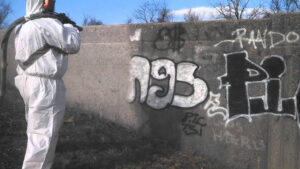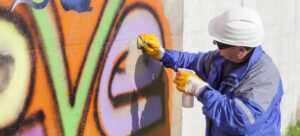Graffiti is often removed by using steam or chemicals. The disadvantage of these techniques is the fact that they’re not always as effective as they should. With other techniques, like sandblasting, there is a risk of damaging or wearing down the underlying layer. This forms a problem with softer stone types and historical buildings.
Laser cleaning is very suitable for removing graffiti. The laser beams will quickly heat up the paint layer, which then will evaporate. The underlying stone or concrete layer remains cool because of its higher ablation temperature. So the laser beams will have no effect on the underlying stone or plaster layer. Even on wood or glass, paint can be removed!

When using sufficiently powerful laser sources, the removal of graffiti goes very fast. At Laserflux, we always work with machines of at least 1000 Watt. This makes it possible for us to clean an area with a width of 10 centimeters in one simple movement. Depending on the age, the color and the thickness of the paint layer, we are able to clean a square meter full of paint in half an hour.
Thanks to its quick cleaning, laser cleaning is comparable in price to the other techniques, but has so much better results.
A handy extra is the fact that we don’t necessarily have to clean at full speed: We can choose the settings so that we don’t make the facade cleaner than the parts around it. It’s not like you want a part of your facade to be cleaner than the other parts, right?
Don’t worry about any waste. The laser cleaning machine has an industrial air extraction installation integrated in it that extracts and filters the evaporated paint. Particles that don’t evaporate but that did come off, are also extracted. You don’t have any cleaning up to do afterwards!


The easiest, fastest and cheapest method. The name says it all: the graffiti is painted over with white or colored paint. With a layer or two you have enough coverage to not see the underlying. The cons also speak for themselves: it doesn’t look like much. A large white rectangle in the middle of a beautiful wall or facade is extremely ugly and above all: it invites for more. After all, you just created a beautiful canvas to welcome a new graffiti drawing. Unless of course you do the entire facade, but then of course it is no longer the cheapest solution.
It seems a logical way, but it is almost impossible. Especially on porous surfaces, your sanding brush or paper will not get deep enough to remove all the paint. This would work on smooth surfaces, but they are quickly damaged by sanding.

Sandblasting works. No discussion possible. The grains of sand fly onto the graffiti at high speed and sand the paint away. But they have the same effect on the underlying wall, steel plate, concrete, etc. Sand is so powerful that it takes away everything, paint as well as stone. There is therefore a real risk of permanent damage to the substrate. Even if not, there is a chance that the cleaned part of the wall will look completely different. After all, the sand grains also have a polishing effect, which changes the color and gloss of a material. Finally, sandblasting also has a lot of grounding in a practical sense: It makes a lot of noise and the surroundings must be completely shielded from the flying (polluted) sand. This is harmful to the environment and should therefore certainly not escape.
A bit similar to sandblasting, but with grains of dry ice that evaporate on impact. Again a very noisy technique that also requires that everything is completely shielded from flying particles. But above all: it is not as effective as sandblasting. As a result, it takes a very long time to remove paint from a surface, with the same effects as sandblasting: the cleaned surface will look different from the surrounding areas.

A chemical product is applied to the graffiti and then has to soak for a while to loosen the bond between the paint and the underlying layer via a chemical reaction. Then the whole is sanded with brushes. This technique has proven itself extensively over the years, but is losing more attention due to its polluting character. This is also not always easy to apply on painted surfaces because the underlying paint can also be affected. When applied to sensitive surfaces such as old facades, there is also a real risk of damage to the facade.
There are also less environmentally harmful products, but these are very expensive and work less well, so that a great deal of product is required. These also do not work in the same way on the different colors, which can leave an appearance of a particular color. This technique is often applied to trains and metro trains, where it is less bad that an appearance is left behind.
This technique has been available for about ten years. It existed before, but was prohibitively expensive for graffiti removal back then. The big advantage is that only light is used and that this light has no effect on anything other than graffiti paint. With the correct setting of the machine, the laser beam will reflect on the underlying layer and therefore have no effect on it. This makes laser cleaning very suitable for sensitive surfaces, old buildings, other paint or paint, etc. Laser cleaning is very environmentally friendly because there is no consumable material, such as sand or dry ice, that remains after the works. This also makes laser cleaning a very practical solution: it is whisper quiet, does not require heavy shields or protective suits and does not leave any dirt behind. A few years ago, laser cleaning was still an expensive solution, but today the prices are comparable to chemical removal or sandblasting. The perfect solution for surfaces smaller than 100m².
Interested in laser cleaning? Experience a free demo at our demo center to see all the advantages of laser cleaning for yourself.